The Hudson’s Bridge To Death
By: Ben Goldfarb
New York’s massive bridge project is killing endangered sturgeon – icon of the Hudson and symbol for Waterkeepers around the globe – and Riverkeeper’s Captain John Lipscomb is demanding action to protect them.
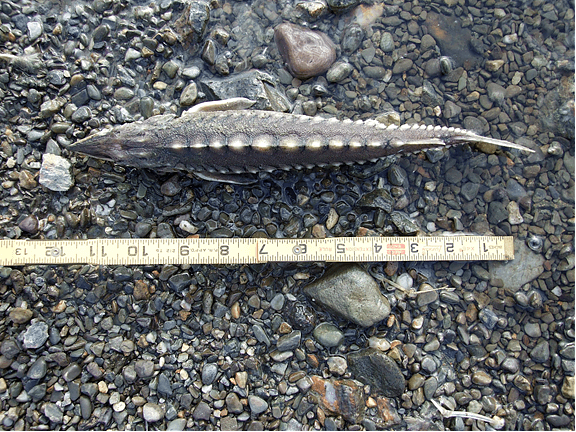
The carcasses began washing up along the Hudson River in the spring of 2012 — one in February, one in March, one in May, then five in June. Concerning, yes, but maybe it was just a blip, an anomaly. Yet the carnage soon got worse — much worse. In 2013, twenty-five bodies, many mangled, appeared on the river. In 2014, the number was 43. In 2015, it was 48. Between 2007 and 2011, just 13 sturgeon had been reported dead in the Hudson River. In the four years after that, the number spiked to 124. This was no random fluctuation. It was a trend.
The bodies belonged to Atlantic and shortnose sturgeon, endangered fish that root for invertebrate prey in the river’s silty bottom.
Sturgeon are among earth’s oldest animals, swimming fossils that have plied the planet’s waterways since before the age of Tyrannosaurus rex. Atlantic sturgeon are the strangest and grandest of the Hudson’s fauna. They live up to 60 years, are bedecked in bony plates, and can grow longer than a man is tall – more than twice the size of their shortnose cousins. Each spring they migrate into the Hudson estuary from the ocean to spawn. But they have been overmatched against human industry. More than a century of harvesting has reduced the fish – once known as “Albany beef” because it was so abundant – to a fraction of its former glory. Since 2012, Atlantic sturgeon up and down the eastern seaboard have been listed under the Endangered Species Act, and a 2007 survey, the most recent peer-reviewed study, estimated that just 870 spawning-age adults remain in the Hudson River Atlantic sturgeon population. Only around a third of those enter the river in any given year to spawn.
Every fish, then, is precious, which is what made the sudden rash of corpses so troubling. Many of the dead sturgeon found between 2012 and 2015 showed signs of mutilation, caused by nasty collisions with boat propellers. New York Department of Environmental Conservation logbooks tell the gruesome story: “large gash along belly”; “caudal severed”; “head missing.” Something, clearly, was making sturgeon more susceptible to boat strikes – and the largest construction project in North America seemed like the obvious culprit.
Just before nightfall on a damp April evening, John Lipscomb, captain of the Riverkeeper’s beautiful 36-foot, wooden-hulled patrol boat, the R. Ian Fletcher, motors out of Westerly Marina in Ossining and cruises downriver toward cloud-obscured New York City. Lipscomb, tall and bespectacled, combines an environmentalist’s fervor with the wry humor of a lifelong mariner. He grew up on the Hudson and managed a boatyard before he began patrolling for Riverkeeper. During the summer Lipscomb has the patrol boat out 21 days a month, testing water samples for fecal contamination. In his years on the water, he’s learned the Hudson’s many moods and forms; the serene gray-scale of dusk is among his favorites.
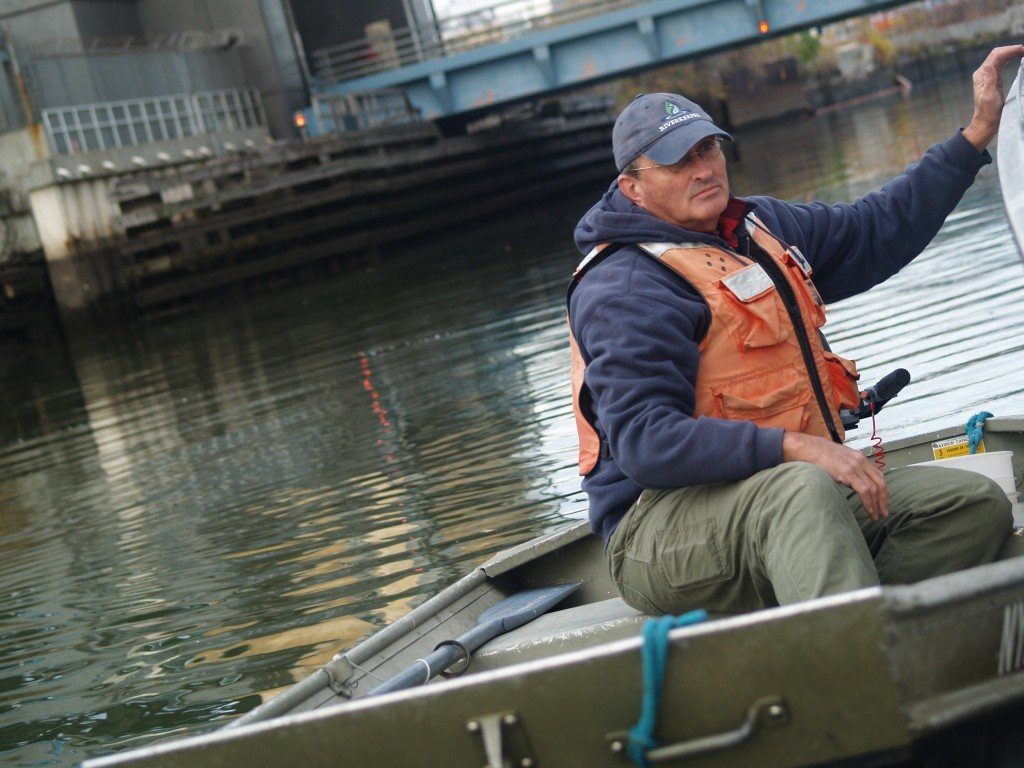
“The houses melt away, the factories melt away, and it’s like a time machine,” he says, smiling blissfully as he eases the boat past an osprey nest perched atop a buoy. “You go back in time and scrub away all the human stuff.”
Soon, however, the human stuff becomes blatantly evident. Massive, half-finished concrete pilings rise out of the gloom, towering cranes appear atop barges, and ant-sized workers scramble over skeletal scaffolds. This is the new Tappan Zee Bridge, the largest bridge project in New York State history, which for three years John Lipscomb has been watchdogging with unwavering tenacity.
The existing three-mile Tappan Zee span, connecting Rockland and Westchester Counties, was built in 1955. In 2011, soon after taking office, Gov. Andrew Cuomo identified bridge replacement as a flagship infrastructure project for his administration. Construction began the following year. The new bridge’s website trumpets that it is “proof that the great state of New York can do amazing things.”
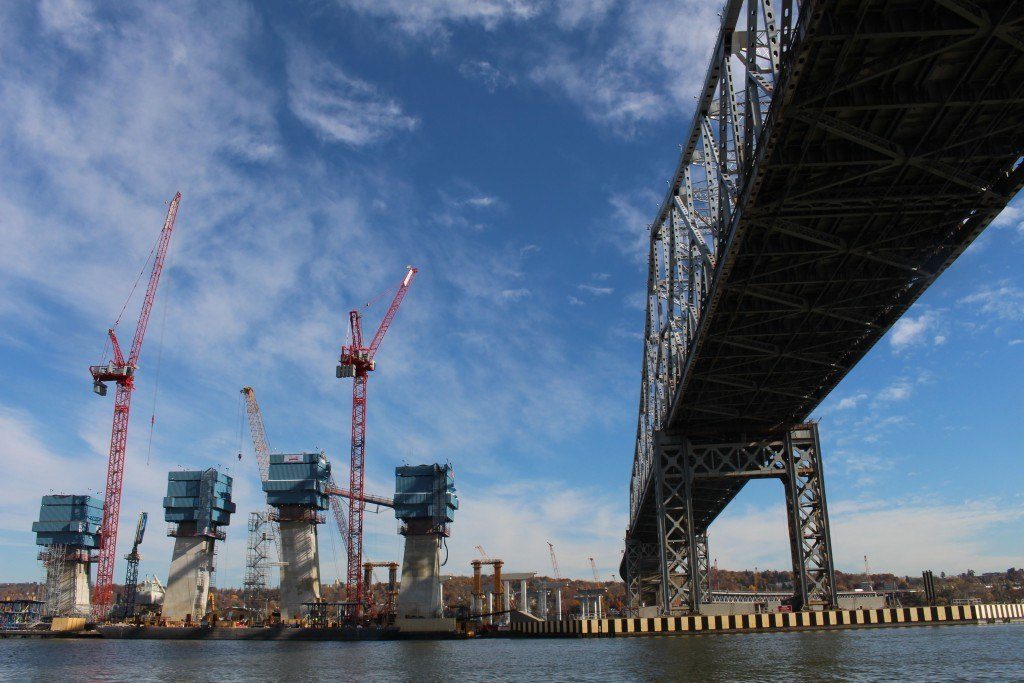
From the start, however, Lipscomb and many others were less than convinced of the project’s virtues. Critics, Lipscomb included, advocated for a tunnel, whose construction would minimally disrupt aquatic life and free this stretch of the Hudson – an area so wide Dutch settlers called it a “sea” – from any human structures. But political momentum made a new bridge a fait accompli, and in March 2013, Riverkeeper signed a deal with New York State. The agreement enabled the organization to monitor the project’s permits, and established funding to compensate the river for the harm construction would inflict. Lipscomb turned his focus from fighting the project to scrutinizing its impacts.
Immediately he noticed problems. To carve out a wide channel for deep-draft construction vessels, the builders deployed dredges to scoop up bucket-loads of sediment and dump it into barges, disrupting almost a million cubic yards of rich benthic habitat. The bridge’s permit required these dredge buckets to move continuously, with no delay, so that the muck, tainted with PCBs and other contaminants, would not spill back into the river. But Lipscomb discovered that crane-operators were pausing midswing to allow turbid water to drip from the dredges. In the fall of 2013, after discussions with the state failed to stop the violations, Riverkeeper notified New York of its intent to sue. Immediately, dredging violations ceased. But the project’s troubles were just beginning.
As Lipscomb approaches the titanic structure on this foggy evening, the construction site buzzes with activity. A fleet of boats, ranging from sleek aluminum skiffs to chugging tugs, orbits the site like small moons. Indecipherable chatter crackles from the radio of a crew-transporter cutting across the patrol boat’s wake. These boats, Lipscomb says, make thousands of trips across the river to move men and equipment for the bridge project. The propellers of the high-speed crew boats and tugs spin dangerously close to sturgeon as the fish feed along the bottom or move to spawning areas. Much of the river beneath the bridge is as shallow as eight feet. The exposed propellers present an obvious hazard to the ancient fish.
“You don’t have to have a Ph.D. in marine biology to figure this stuff out,” says the captain as the Fletcher passes beneath the bridge’s underbelly.
Despite the commonsense connection, the state claimed that increased reports of dead sturgeon could be explained by recent research suggesting that juvenile sturgeon are growing more abundant in the Hudson. Another hypothesis is that people who advocate for the river became more sensitive to the Atlantic sturgeon’s plight after it was listed as endangered in 2012. “While we agree that the number of reports has increased over the last few years,” one official wrote, “it also seems that the level of interest and effort to report these sightings has increased.”
Lipscomb has no patience with these demurrers. “The claim that more juvenile fish proves that there are more spawning age adults isn’t science, it’s propaganda. It could be, for example, that there are more juvenile sturgeon because there are fewer predators – a distinct possibility in a river out of balance.”
He dismisses the “more eyes on the river” claim as equally specious, on the grounds that the public has long been alert to ecological disturbance. In 2002, for instance, when rapidly warming waters caused a massive die-off of white perch, Riverkeeper’s phone “rang off the hook.”
“Don’t tell me there hasn’t always been robust reporting,” he says. “That shows an ignorance and a disrespect of the public’s concern for this river.”
The project’s proponents have also been quick to point out that dead sturgeon have been found from New York Harbor to Troy, more than 100 miles from the bridge. But Lipscomb is equally unimpressed by that argument.
“When you hit a deer with your car and the deer is injured,” he asks, “does it stand by the side of the road or does it run like hell into the woods? Sturgeon are tough — they don’t die right away, they swim.”
Moreover, Riverkeeper has determined that the center point of all the reported dead fish is less than a mile from the bridge. Despite this telling evidence, Lipscomb admits that bridge construction probably isn’t responsible for all 124 slain sturgeon. But even if only a quarter were whacked by project boats, the project would still have far exceeded its federal allowance to kill two Atlantic sturgeon and two shortnose – and none from vessel strikes.
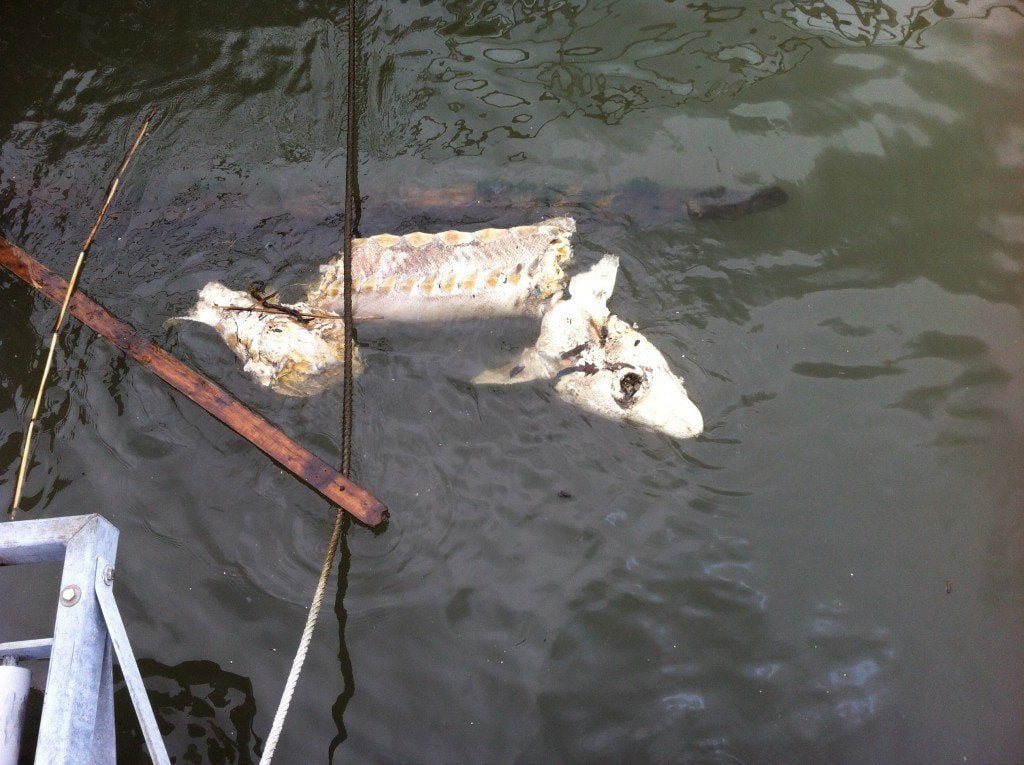
“Whether it’s 10 fish or 20 fish or 30 fish, this is clearly a violation,” Lipcomb says, his voice rising in righteous indignation.
In December 2015, Hudson Riverkeeper filed a notice of intent to sue the New York State Thruway Authority and its contractor on the Tappan Zee project. Not only were propellers killing sturgeon, it stated, but boats were also illegally stirring up contaminated sediment farther than 500 feet from construction activity. Sediment in the area of the bridge contains mercury, copper, lead and other contaminants. Myriad aerial photographs from volunteer pilots over the years reveal snaking plumes of muck.
“Governor Cuomo promised that this would be the most environmentally sensitive infrastructure project in New York’s history,” says Riverkeeper President Paul Gallay. “The state has not come anywhere close to living up to that promise.”
Despite ample evidence that project vessels are killing sturgeon, state and federal agencies have not added any new protections for the fish. Although the National Marine Fisheries Service acknowledges that project vessels are killing sturgeon, the agency has simply increased the number of fish that the project is allowed to kill.
“Over half a year of review by the Fisheries Service, and it appears the federal agency that’s mandated to use the best available science to protect the endangered species has in fact done everything it can to protect the project,” Lipscomb says. “I couldn’t be more discouraged. I actually had hope that the federal agency would do the right thing.”
The state, for its part, continues to deny any connection between the bridge project and even a single sturgeon mortality. At press time, Riverkeeper continues to pursue settlement and the option of a lawsuit remains open.
Lipscomb already has suggestions about how the state can meet its obligations. His first proposed change is a simple one: a speed limit. The original biological opinion from the National Marine Fisheries Service assumed that all boats would travel below 6 knots near the bridge, but no speed limits were enforced for project vessels. Lipscomb has documented boats zipping along at up to 35 knots.
“If a school zone is posted at 15 mph and you have kids in the neighborhood, and you go out every morning and see a guy in a red pickup going 50, you bust him,” he says. “This is the same deal.”
He also wants metal cages around propellers on tugs and crew boats. This former boatyard-manager solicited a friend to scour yards in Maine and photograph vessels with cages, which are employed to avoid entanglement with lobstertraps. He also called naval architects, who directed him to vessels in Florida, Georgia and the Amazon that use similar contraptions. The Georgia example was especially telling: After a fleet of Navy tugboats that had been killing manatees was fitted with propeller cages, the manatee deaths ceased. “For a service like the Navy to be more responsive than the New York State Thruway Authority is really sad,” Lipscomb says.
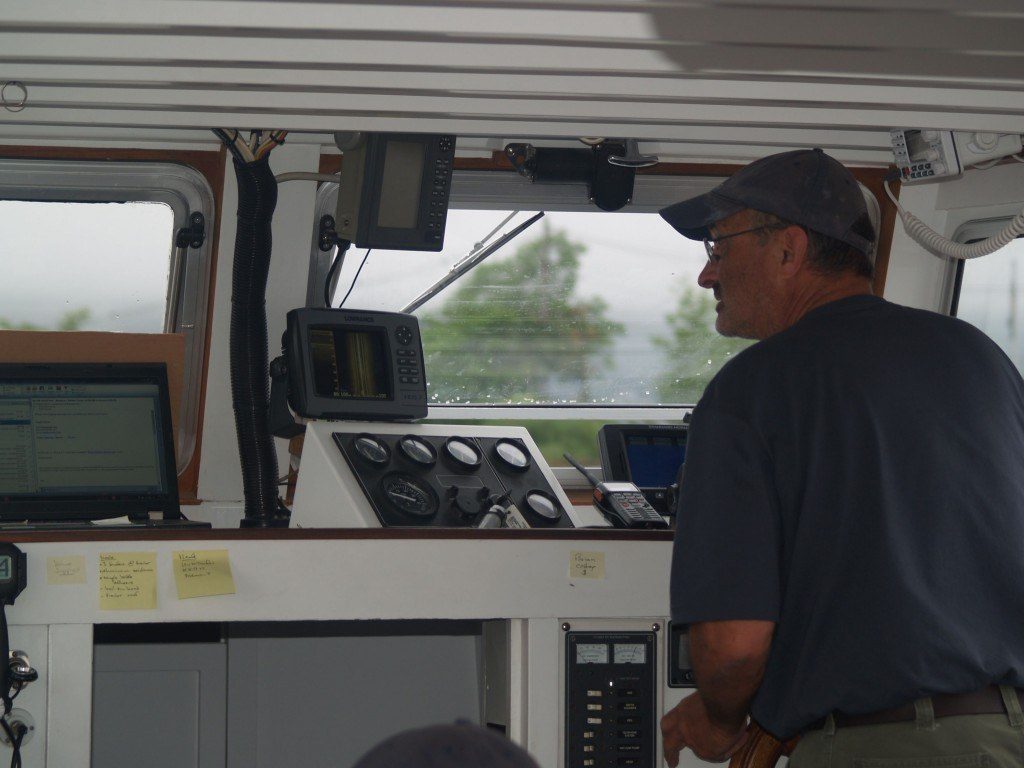
Still, speed limits and protective cages won’t bring fish back to life, nor will they prevent the illegal disturbance of sediment. In addition to operational changes, therefore, Riverkeeper also seeks compensation to the river, perhaps in the form of new sturgeon population studies, invasive species control, or the removal of dams from the Hudson’s tributaries. Just $10 million of the Tappan Zee’s $4 billion budget is now devoted to environmental mitigation – a pittance, Lipscomb insists, compared to funding for other large projects.
In the decades since 1966, the year a journalist and fly-fisherman named Bob Boyle founded the Hudson River Fishermen’s Association, the progenitor of Hudson Riverkeeper and Waterkeeper Alliance, Riverkeeper and its predecessors have never had to deal with a construction project as massive as the new Tappan Zee. But over that halfcentury they have defeated an infamous hydroelectric facility proposed for Storm King Mountain, stymied construction of a new West Side highway that would have wiped out striped-bass habitat, and hounded a never-ending succession of industrial polluters. Defending sturgeon from propellers wasn’t how Riverkeeper wanted to celebrate its fiftieth anniversary, yet it’s also a fitting way to mark the occasion.
“Riverkeeper has spent 50 years trying to provide for a healthy, thriving aquatic ecosystem in the Hudson River,” Gallay says. “The damage that the Tappan Zee Bridge has been doing to an iconic species is the kind of thing we’ve always fought, and that we’ll continue to fight. We’ve made too much progress to turn back now.”
Wherever that fight leads, it’s a safe bet that Paul Gallay and John Lipscomb will be on the front lines. After the recent tour of the construction site, Lipscomb cruises back toward the marina, a light drizzle now spattering the R. Ian Fletcher’s windshield. The boat bounces along at a leisurely 6 knots, and Lipscomb listens to the steady thrum of the engine, his ears attuned to the slightest change in pitch.
“Any sound that doesn’t belong on a boat is like fingernails on a chalkboard,” he says.
It’s the same way the captain watches and listens to the Hudson River ecosystem —hypervigilant, alert to change, mindful not only of the river’s outward appearance but of its innermost conditions.
“Even though I grew up here, I didn’t have an appreciation for the river,” he says. “I treated it the way most people do: as a surface that you swim and sail on. But the river you can see is not the real river.” And what’s the real river? It’s the sturgeon, the shad, the striped bass, the bountiful hidden life migrating and feeding and spawning beneath the opaque tide. “I’ve come to appreciate them the same as if I were on a safari,” he says. “This is a wilderness that runs right through the heart of New York City and our state.”
Ben Goldfarb is a correspondent for High Country News. His writing has also appeared in Scientific American, Earth Island Journal, and Orion.